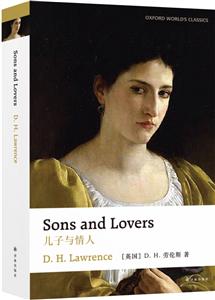儿子与情人

|
儿子与情人作者:D.H.劳伦斯 开 本:32开 书号ISBN:9787544773171 定价: 出版时间:2018-06-01 出版社:译林 |
儿子与情人 本书特色
本书为Duckworth出版的1913年初版版本,附有小说文本解读,由伦敦大学学院英语文学教授David Trotter导读并撰写注释。 1,版本 该系列丛书是从牛津大学出版社引进的精校版本,是牛津大学出版社延续百年的版本 2,高水准的名家导读 由牛津、剑桥等名校教授撰写导读文章,对提升读者的阅读鉴赏能力大有裨益 3,便利的阅读体验 全书有丰富的注释、词汇解析和完备的背景知识介绍,非常适合自主阅读,提升阅读能力 4,合理的品种组合 在浩如烟海的典籍中,牛津大学出版社根据多年数据积累,优选了有阅读价值的文学、社科等品种 Oxford World’s Classics系牛津大学出版社百年积淀的精品书系。此番由译林出版社原版引进。除牛津品牌保证的*威原著版本之外,每册书附含名家导读、作家简介及年表、词汇解析、文本注释、背景知识拓展、同步阅读导引、版本信息等,特别适合作为大学生和学有余力的中学生英语学习的必读材料。导读者包括牛津和剑桥大学的资深教授和知名学者。整套书选目精良,便携易读,实为亲近世界级名著的经典读本。
儿子与情人 内容简介
《儿子与情人》是劳伦斯的成名作,是他早期创作中*成熟、*有影响力的作品。矿工沃尔特?莫雷尔与敏感、清高的妻子失败的婚姻生活深深地影响了两个儿子的人生,母亲强烈、带占有性质的爱,尤其让小儿子保罗感到窒息,迫使他一有机会就设法逃脱,而在短暂的逃离中,他又常常被母亲那无形的精神枷锁牵引着,痛苦得不能自已。 *初,该书因为被斥为“有伤风化”的色情文学而先后在英美等国被禁止发行。20世纪60年代,经过轰动性的法庭审判方才解禁。随着人们对其作品认识的深入,它已被誉为世界文学名著长廊中独具特色的佳作。1999年,小说被评为“20世纪英国百部*佳小说”。
儿子与情人 目录
CONTENTS Acknowledgements Introduction Note on the Text Select Bibliography A Chronology of D. H. Lawrence SONS AND LOVERS Appendix Explanatory Notes ? ?儿子与情人 节选
PART I CHAPTER I THE EARLY MARRIED LIFE OF THE MORELS ‘THE BOTTOMS’ succeeded to ‘Hell Row’. Hell Row was a block of thatched, bulging cottages that stood by the brook-side on Greenhill Lane. There lived the colliers who worked in the little gin-pits two fields away. The brook ran under the alder-trees, scarcely soiled by these small mines, whose coal was drawn to the surface by donkeys that plodded wearily in a circle round a gin. And all over the countryside were these same pits, some of which had been worked in the time of Charles II, the few colliers and the donkeys burrowing down like ants into the earth, making queer mounds and little black places among the corn-fields and the meadows. And the cottages of these coalminers, in blocks and pairs here and there, together with odd farms and homes of the stockingers, straying over the parish, formed the village of Bestwood. Then, some sixty years ago, a sudden change took place. The gin-pits were elbowed aside by the large mines of the financiers. The coal and iron field of Nottinghamshire and Derbyshire was discovered. Carston, Waite and Co. appeared. Amid tremendous excitement, Lord Palmerston formally opened the company’s first mine at Spinney Park, on the edge of Sherwood Forest. About this time the notorious Hell Row, which through growing old had acquired an evil reputation, was burned down, and much dirt was cleansed away. Carston, Waite and Co. found they had struck on a good thing, so, down the valleys of the brooks from Selby and Nuttall, new mines were sunk, until soon there were six pits working. From Nuttall, high up on the sandstone among the woods, the railway ran, past the ruined priory of the Carthusians and past Robin Hood’s Well, down to Spinney Park, then on to Minton, a large mine among corn-fields; from Minton across the farm-lands of the valleyside to Bunker’s Hill, branching off there, and running north to Beggarlee and Selby, that looks over at Crich and the hills of Derbyshire; six mines like black studs on the countryside, linked by a loop of fine chain, the railway. To accommodate the regiments ofminers, Carston, Waite and Co. built the Squares, great quadrangles of dwellings on the hillside of Bestwood, and then, in the brook valley, on the site of Hell Row, they erected the Bottoms. The Bottoms consisted of six blocks of miners’ dwellings, two rows of three, like the dots on a blank-six domino, and twelve houses in a block. This double row of dwellings sat at the foot of the rather sharp slope from Bestwood, and looked out, from the attic windows at least, on the slow climb of the valley towards Selby. The houses themselves were substantial and very decent. One could walk all round, seeing little front gardens with auriculas and saxifrage in the shadow of the bottom block, sweet-williams and pinks in the sunny top block; seeing neat front windows, little porches, little privet hedges, and dormer windows for the attics. But that was outside; that was the view on to the uninhabited parlours of all the colliers’ wives. The dwelling-room, the kitchen, was at the back of the house, facing inward between the blocks, looking at a scrubby back garden, and then at the ash-pits. And between the rows, between the long lines of ash-pits, went the alley, where the children played and the women gossiped and the men smoked. So, the actual conditions of living in the Bottoms, that was so well built and that looked so nice, were quite unsavoury because people must live in the kitchen, and the kitchens opened on to that nasty alley of ash-pits. Mrs Morel was not anxious to move into the Bottoms, which was already twelve years old and on the downward path, when she descended to it from Bestwood. But it was the best she could do. Moreover, she had an end house in one of the top blocks, and thus had only one neighbour; on the other side an extra strip of garden. And, having an end house, she enjoyed a kind of aristocracy among the other women of the ‘between’ houses, because her rent was five shillings and sixpence instead of five shillings a week. But this superiority in station was not much consolation to Mrs Morel. She was thirty-one years old, and had been married eight years. A rather small woman, of delicate mould but resolute bearing, she shrank a little from the first contact with the Bottoms women. She came down in the July, and in the September expected her third baby. Her husband was a miner. They had only been in their new home three weeks when the wakes, or fair, began. Morel, she knew, was sure to make a holiday of it. He went off early on the Monday morning, the day of the fair. The two children were highly excited. William, a boy of seven, fled off immediately after breakfast, to prowl round the wakes ground, leaving Annie, who was only five, to whine all morning to go also. Mrs Morel did her work. She scarcely knew her neighbours yet, and knew no one with whom to trust the little girl. So she promised to take her to the wakes after dinner. William appeared at half-past twelve. He was a very active lad, fair-haired, freckled, with a touch of the Dane or Norwegian about him.
中小学教辅 英语阅读
在线阅读
- 最新内容
- 相关内容
- 网友推荐
- 图文推荐
| [高考] 2022 西安电子科技大学《软件工程》大作业答案 (2022-04-25) |
| [家长教育] 孩子为什么会和父母感情疏离? (2019-07-14) |
| [教师分享] 给远方姐姐的一封信 (2018-11-07) |
| [教师分享] 伸缩门 (2018-11-07) |
| [教师分享] 回家乡 (2018-11-07) |
| [教师分享] 是风味也是人间 (2018-11-07) |
| [教师分享] 一句格言的启示 (2018-11-07) |
| [教师分享] 无规矩不成方圆 (2018-11-07) |
| [教师分享] 第十届全国教育名家论坛有感(二) (2018-11-07) |
| [教师分享] 贪玩的小狗 (2018-11-07) |






